ignition NISSAN ROGUE SPORT 2020 Owners Manual
[x] Cancel search | Manufacturer: NISSAN, Model Year: 2020, Model line: ROGUE SPORT, Model: NISSAN ROGUE SPORT 2020Pages: 492, PDF Size: 2.02 MB
Page 14 of 492

0-6Illustrated table of contents
WAA0118X
1. Instrument brightness control (P.2-9)
2. TRIP RESET switch (P.2-6)
3. Headlight and turn signal switch (P.2-53)/Fog light switch* (P.2-58)
4. Steering-wheel-mounted controls (left side)
— Audio control** — Vehicle information display control
(P.2-20)
5. Steering wheel (P.3-30) — Horn (P.2-59)
6. Wiper and washer switch (P.2-49)
7. Hazard indicator flasher switch (P.6-2)
8. Steering-wheel-mounted controls (right side) — Intelligent Lane Intervention (I-LI)
(P.5-40)
— Cruise control switches* (P.5-64)
— ProPILOT assist* (P.5-66)
— Bluetooth® Hands-Free Phone Sys-
tem**
— Voice Recognition system switch**
— Siri® Eyes Free**
9. Shift lever — Continuously Variable Transmission
(CVT) (P.5-20)
— Manual Transmission (MT) (P.5-25)
10. Vehicle Dynamic Control (VDC) OFF switch (P.2-62)
11. Heated steering wheel switch* (P.2-59)
12. Parking brake (Pedal type) (P.5-27)
13. Intelligent 4x4 LOCK switch* (P.2-63)
14. Steering assist switch* (models with Pro- PILOT assist) (P.2-62, P.5-66) or Dynamic
driver assistance switch* (models without
ProPILOT assist) (P.2-61, P.5-40)
15. SPORT mode switch* (P.5-32)
16. ECO switch (P.5-32)
17. Push-button ignition switch (model with Intelligent Key system) (P.5-14)
18. Ignition switch (model without Intelligent Key system) (P.5-12)
19. Parking brake (Switch type) (P.5-27)
20. Automatic brake hold switch* (P.5-29)
*: if so equipped
**: See the separate NissanConnect® Own- er’s Manual (if so equipped).
COCKPIT
Page 31 of 492
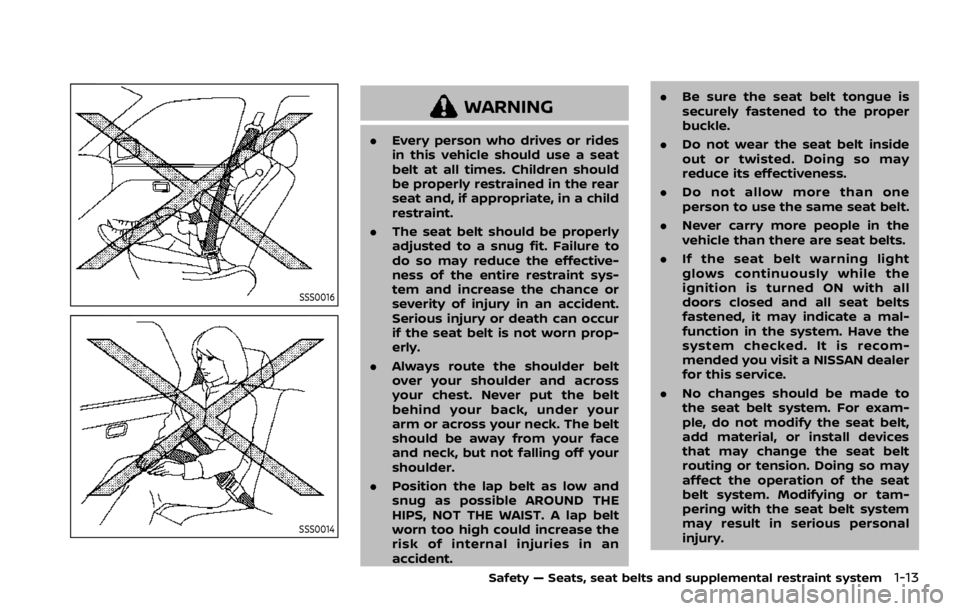
SSS0016
SSS0014
WARNING
.Every person who drives or rides
in this vehicle should use a seat
belt at all times. Children should
be properly restrained in the rear
seat and, if appropriate, in a child
restraint.
. The seat belt should be properly
adjusted to a snug fit. Failure to
do so may reduce the effective-
ness of the entire restraint sys-
tem and increase the chance or
severity of injury in an accident.
Serious injury or death can occur
if the seat belt is not worn prop-
erly.
. Always route the shoulder belt
over your shoulder and across
your chest. Never put the belt
behind your back, under your
arm or across your neck. The belt
should be away from your face
and neck, but not falling off your
shoulder.
. Position the lap belt as low and
snug as possible AROUND THE
HIPS, NOT THE WAIST. A lap belt
worn too high could increase the
risk of internal injuries in an
accident. .
Be sure the seat belt tongue is
securely fastened to the proper
buckle.
. Do not wear the seat belt inside
out or twisted. Doing so may
reduce its effectiveness.
. Do not allow more than one
person to use the same seat belt.
. Never carry more people in the
vehicle than there are seat belts.
. If the seat belt warning light
glows continuously while the
ignition is turned ON with all
doors closed and all seat belts
fastened, it may indicate a mal-
function in the system. Have the
system checked. It is recom-
mended you visit a NISSAN dealer
for this service.
. No changes should be made to
the seat belt system. For exam-
ple, do not modify the seat belt,
add material, or install devices
that may change the seat belt
routing or tension. Doing so may
affect the operation of the seat
belt system. Modifying or tam-
pering with the seat belt system
may result in serious personal
injury.
Safety — Seats, seat belts and supplemental restraint system1-13
Page 32 of 492
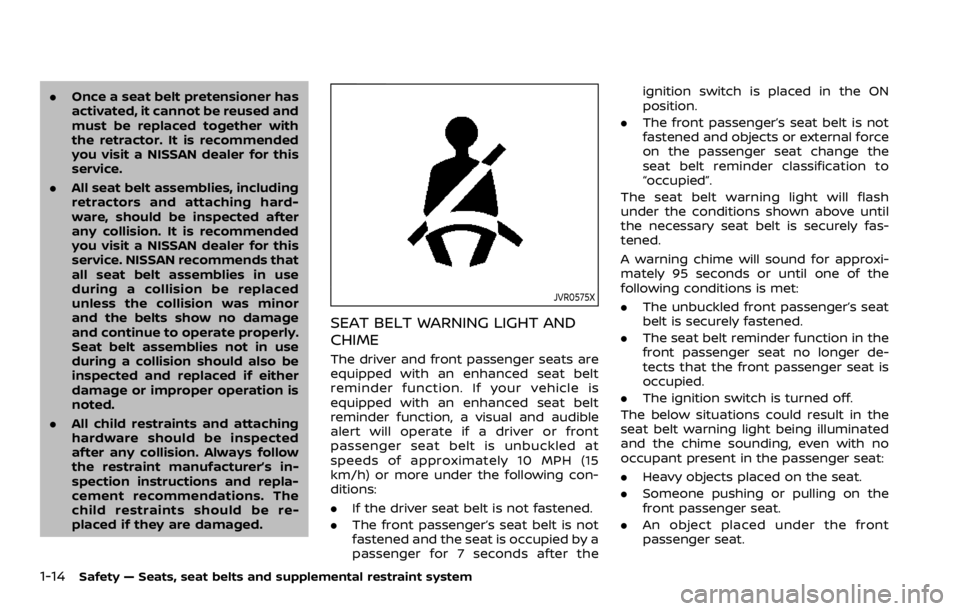
1-14Safety — Seats, seat belts and supplemental restraint system
.Once a seat belt pretensioner has
activated, it cannot be reused and
must be replaced together with
the retractor. It is recommended
you visit a NISSAN dealer for this
service.
. All seat belt assemblies, including
retractors and attaching hard-
ware, should be inspected after
any collision. It is recommended
you visit a NISSAN dealer for this
service. NISSAN recommends that
all seat belt assemblies in use
during a collision be replaced
unless the collision was minor
and the belts show no damage
and continue to operate properly.
Seat belt assemblies not in use
during a collision should also be
inspected and replaced if either
damage or improper operation is
noted.
. All child restraints and attaching
hardware should be inspected
after any collision. Always follow
the restraint manufacturer’s in-
spection instructions and repla-
cement recommendations. The
child restraints should be re-
placed if they are damaged.
JVR0575X
SEAT BELT WARNING LIGHT AND
CHIME
The driver and front passenger seats are
equipped with an enhanced seat belt
reminder function. If your vehicle is
equipped with an enhanced seat belt
reminder function, a visual and audible
alert will operate if a driver or front
passenger seat belt is unbuckled at
speeds of approximately 10 MPH (15
km/h) or more under the following con-
ditions:
.If the driver seat belt is not fastened.
. The front passenger’s seat belt is not
fastened and the seat is occupied by a
passenger for 7 seconds after the ignition switch is placed in the ON
position.
. The front passenger’s seat belt is not
fastened and objects or external force
on the passenger seat change the
seat belt reminder classification to
“occupied”.
The seat belt warning light will flash
under the conditions shown above until
the necessary seat belt is securely fas-
tened.
A warning chime will sound for approxi-
mately 95 seconds or until one of the
following conditions is met:
. The unbuckled front passenger’s seat
belt is securely fastened.
. The seat belt reminder function in the
front passenger seat no longer de-
tects that the front passenger seat is
occupied.
. The ignition switch is turned off.
The below situations could result in the
seat belt warning light being illuminated
and the chime sounding, even with no
occupant present in the passenger seat:
. Heavy objects placed on the seat.
. Someone pushing or pulling on the
front passenger seat.
. An object placed under the front
passenger seat.
Page 60 of 492

1-42Safety — Seats, seat belts and supplemental restraint system
PRECAUTIONS ON SRS
This SRS section contains important in-
formation concerning the following sys-
tems:
.Driver and front passenger supple-
mental front-impact air bag (NISSAN
Advanced Air Bag System)
. Driver and passenger supplemental
knee air bag
. Front seat-mounted side-impact sup-
plemental air bag
. Rear outboard seat-mounted side-
impact supplemental air bag
. Roof-mounted curtain side-impact
and rollover supplemental air bag
. Seat belt with pretensioner (front and
rear outboard seats)
Supplemental front-impact air bag sys-
tem: The NISSAN Advanced Air Bag Sys-
tem can help cushion the impact force to
the head and chest of the driver and front
passenger in certain frontal collisions.
Driver and passenger supplemental
knee air bag system: This system can
help cushion the impact force to the
driver’s and front passenger’s knees in
certain collisions.
Front seat-mounted side-impact sup-
plemental air bag system: This system
can help cushion the impact force to the
chest and pelvic area of the driver and front passenger in certain side impact
collisions. The side air bag is designed to
inflate on the side where the vehicle is
impacted.
Rear outboard seat-mounted side-im-
pact supplemental air bag system:
This
system can help cushion the impact force
to the chest area of the rear outboard
seat passengers in certain side-impact
collisions. The side air bags are designed
to inflate on the side where the vehicle is
impacted.
Roof-mounted curtain side-impact and
rollover supplemental air bag system:
This system can help cushion the impact
force to the heads of occupants in front
and rear outboard seating positions in
certain side impact or rollover collisions.
In a side-impact, the curtain air bags are
designed to inflate on the side where the
vehicle is impacted. In a rollover, the
curtain air bags on both sides are de-
signed to inflate. Under both side-impact
and rollover situations, the curtain air
bags will remain inflated for a short
period of time.
These supplemental restraint systems are
designed to supplement the crash pro-
tection provided by the driver, passenger
and rear outboard seat belts and are not
a substitute for them. Seat belts should
always be correctly worn and the occu- pant seated a suitable distance away
from the steering wheel, instrument pa-
nel and door finishers. (See “Seat belts”
(P.1-12) for instructions and precautions
on seat belt usage.)
The supplemental air bags operate only
when the ignition switch is in the ON or
START position.
After the ignition is placed in the ON
position, the supplemental air bag
warning light illuminates. The supple-
mental air bag warning light will turn
off after about 7 seconds if the systems
are operational.
SUPPLEMENTAL RESTRAINT SYSTEM (SRS)
Page 68 of 492
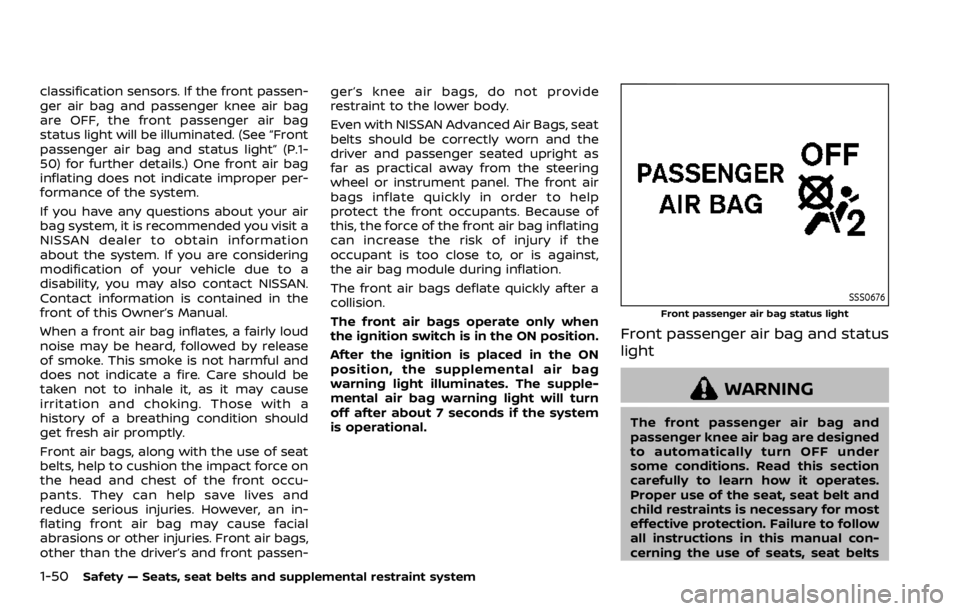
1-50Safety — Seats, seat belts and supplemental restraint system
classification sensors. If the front passen-
ger air bag and passenger knee air bag
are OFF, the front passenger air bag
status light will be illuminated. (See “Front
passenger air bag and status light” (P.1-
50) for further details.) One front air bag
inflating does not indicate improper per-
formance of the system.
If you have any questions about your air
bag system, it is recommended you visit a
NISSAN dealer to obtain information
about the system. If you are considering
modification of your vehicle due to a
disability, you may also contact NISSAN.
Contact information is contained in the
front of this Owner’s Manual.
When a front air bag inflates, a fairly loud
noise may be heard, followed by release
of smoke. This smoke is not harmful and
does not indicate a fire. Care should be
taken not to inhale it, as it may cause
irritation and choking. Those with a
history of a breathing condition should
get fresh air promptly.
Front air bags, along with the use of seat
belts, help to cushion the impact force on
the head and chest of the front occu-
pants. They can help save lives and
reduce serious injuries. However, an in-
flating front air bag may cause facial
abrasions or other injuries. Front air bags,
other than the driver’s and front passen-ger’s knee air bags, do not provide
restraint to the lower body.
Even with NISSAN Advanced Air Bags, seat
belts should be correctly worn and the
driver and passenger seated upright as
far as practical away from the steering
wheel or instrument panel. The front air
bags inflate quickly in order to help
protect the front occupants. Because of
this, the force of the front air bag inflating
can increase the risk of injury if the
occupant is too close to, or is against,
the air bag module during inflation.
The front air bags deflate quickly after a
collision.
The front air bags operate only when
the ignition switch is in the ON position.
After the ignition is placed in the ON
position, the supplemental air bag
warning light illuminates. The supple-
mental air bag warning light will turn
off after about 7 seconds if the system
is operational.
SSS0676
Front passenger air bag status light
Front passenger air bag and status
light
WARNING
The front passenger air bag and
passenger knee air bag are designed
to automatically turn OFF under
some conditions. Read this section
carefully to learn how it operates.
Proper use of the seat, seat belt and
child restraints is necessary for most
effective protection. Failure to follow
all instructions in this manual con-
cerning the use of seats, seat belts
Page 69 of 492

and child restraints can increase the
risk or severity of injury in an acci-
dent.Status light:
The front passenger seat is equipped with
occupant classification sensors (weight
sensors) that turn the front passenger air
bag and passenger knee air bag on or off
depending on the weight applied to the
front passenger seat. The status of the
front passenger air bag and passenger
knee air bag (ON or OFF) is indicated by
the front passenger air bag status light
which is located on the instrument
panel. After the ignition switch is placed in
the ON position, the front passenger air
bag status light illuminates for about 7
seconds and then turns off or remains
illuminate depending on the front pas-
senger seat occupied status. The light
operates as follows:
Safety — Seats, seat belts and supplemental restraint system1-51
Page 76 of 492
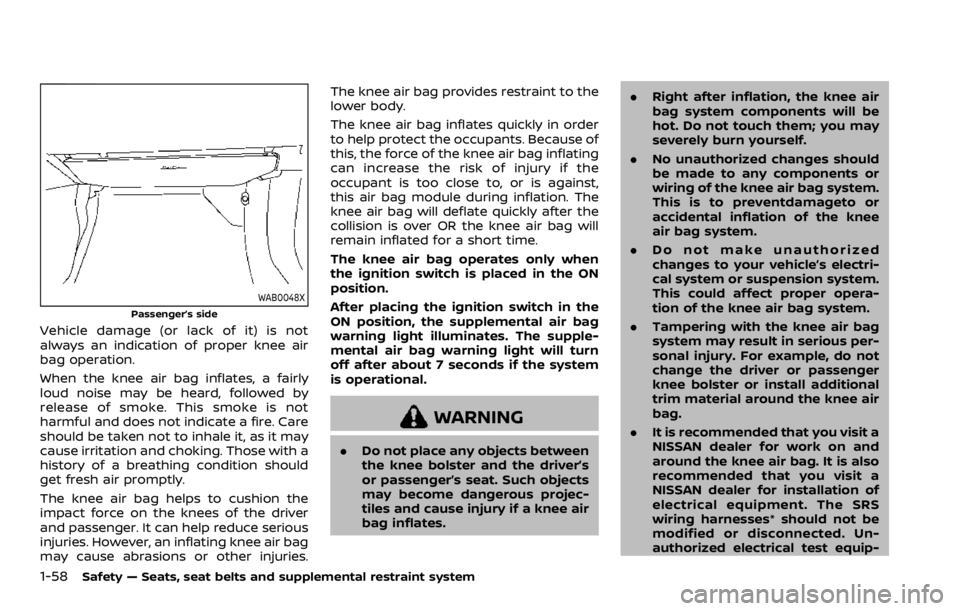
1-58Safety — Seats, seat belts and supplemental restraint system
WAB0048X
Passenger’s side
Vehicle damage (or lack of it) is not
always an indication of proper knee air
bag operation.
When the knee air bag inflates, a fairly
loud noise may be heard, followed by
release of smoke. This smoke is not
harmful and does not indicate a fire. Care
should be taken not to inhale it, as it may
cause irritation and choking. Those with a
history of a breathing condition should
get fresh air promptly.
The knee air bag helps to cushion the
impact force on the knees of the driver
and passenger. It can help reduce serious
injuries. However, an inflating knee air bag
may cause abrasions or other injuries.The knee air bag provides restraint to the
lower body.
The knee air bag inflates quickly in order
to help protect the occupants. Because of
this, the force of the knee air bag inflating
can increase the risk of injury if the
occupant is too close to, or is against,
this air bag module during inflation. The
knee air bag will deflate quickly after the
collision is over OR the knee air bag will
remain inflated for a short time.
The knee air bag operates only when
the ignition switch is placed in the ON
position.
After placing the ignition switch in the
ON position, the supplemental air bag
warning light illuminates. The supple-
mental air bag warning light will turn
off after about 7 seconds if the system
is operational.
WARNING
.
Do not place any objects between
the knee bolster and the driver’s
or passenger’s seat. Such objects
may become dangerous projec-
tiles and cause injury if a knee air
bag inflates. .
Right after inflation, the knee air
bag system components will be
hot. Do not touch them; you may
severely burn yourself.
. No unauthorized changes should
be made to any components or
wiring of the knee air bag system.
This is to preventdamageto or
accidental inflation of the knee
air bag system.
. Do not make unauthorized
changes to your vehicle’s electri-
cal system or suspension system.
This could affect proper opera-
tion of the knee air bag system.
. Tampering with the knee air bag
system may result in serious per-
sonal injury. For example, do not
change the driver or passenger
knee bolster or install additional
trim material around the knee air
bag.
. It is recommended that you visit a
NISSAN dealer for work on and
around the knee air bag. It is also
recommended that you visit a
NISSAN dealer for installation of
electrical equipment. The SRS
wiring harnesses* should not be
modified or disconnected. Un-
authorized electrical test equip-
Page 78 of 492
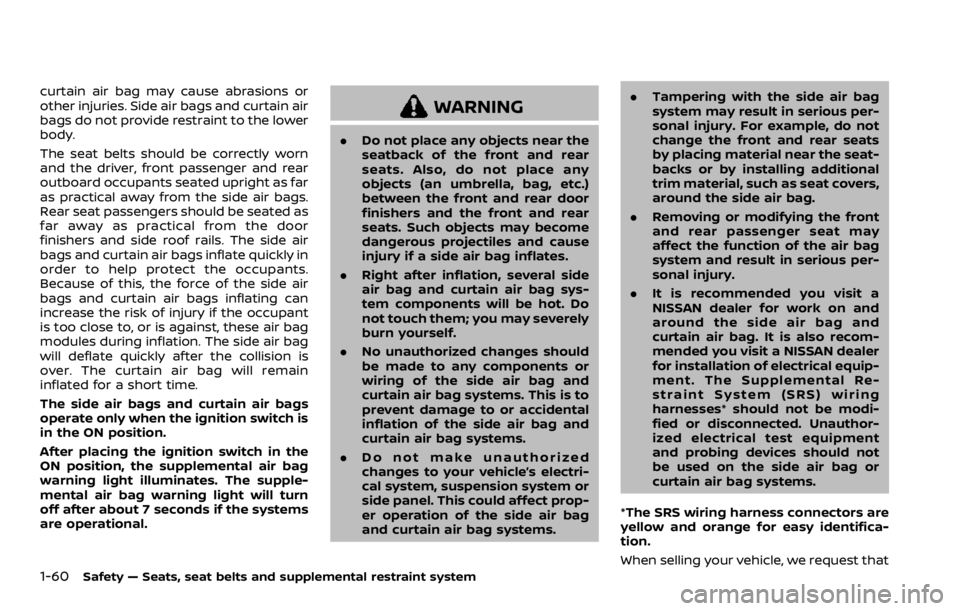
1-60Safety — Seats, seat belts and supplemental restraint system
curtain air bag may cause abrasions or
other injuries. Side air bags and curtain air
bags do not provide restraint to the lower
body.
The seat belts should be correctly worn
and the driver, front passenger and rear
outboard occupants seated upright as far
as practical away from the side air bags.
Rear seat passengers should be seated as
far away as practical from the door
finishers and side roof rails. The side air
bags and curtain air bags inflate quickly in
order to help protect the occupants.
Because of this, the force of the side air
bags and curtain air bags inflating can
increase the risk of injury if the occupant
is too close to, or is against, these air bag
modules during inflation. The side air bag
will deflate quickly after the collision is
over. The curtain air bag will remain
inflated for a short time.
The side air bags and curtain air bags
operate only when the ignition switch is
in the ON position.
After placing the ignition switch in the
ON position, the supplemental air bag
warning light illuminates. The supple-
mental air bag warning light will turn
off after about 7 seconds if the systems
are operational.
WARNING
.Do not place any objects near the
seatback of the front and rear
seats. Also, do not place any
objects (an umbrella, bag, etc.)
between the front and rear door
finishers and the front and rear
seats. Such objects may become
dangerous projectiles and cause
injury if a side air bag inflates.
. Right after inflation, several side
air bag and curtain air bag sys-
tem components will be hot. Do
not touch them; you may severely
burn yourself.
. No unauthorized changes should
be made to any components or
wiring of the side air bag and
curtain air bag systems. This is to
prevent damage to or accidental
inflation of the side air bag and
curtain air bag systems.
. Do not make unauthorized
changes to your vehicle’s electri-
cal system, suspension system or
side panel. This could affect prop-
er operation of the side air bag
and curtain air bag systems. .
Tampering with the side air bag
system may result in serious per-
sonal injury. For example, do not
change the front and rear seats
by placing material near the seat-
backs or by installing additional
trim material, such as seat covers,
around the side air bag.
. Removing or modifying the front
and rear passenger seat may
affect the function of the air bag
system and result in serious per-
sonal injury.
. It is recommended you visit a
NISSAN dealer for work on and
around the side air bag and
curtain air bag. It is also recom-
mended you visit a NISSAN dealer
for installation of electrical equip-
ment. The Supplemental Re-
straint System (SRS) wiring
harnesses* should not be modi-
fied or disconnected. Unauthor-
ized electrical test equipment
and probing devices should not
be used on the side air bag or
curtain air bag systems.
*The SRS wiring harness connectors are
yellow and orange for easy identifica-
tion.
When selling your vehicle, we request that
Page 80 of 492
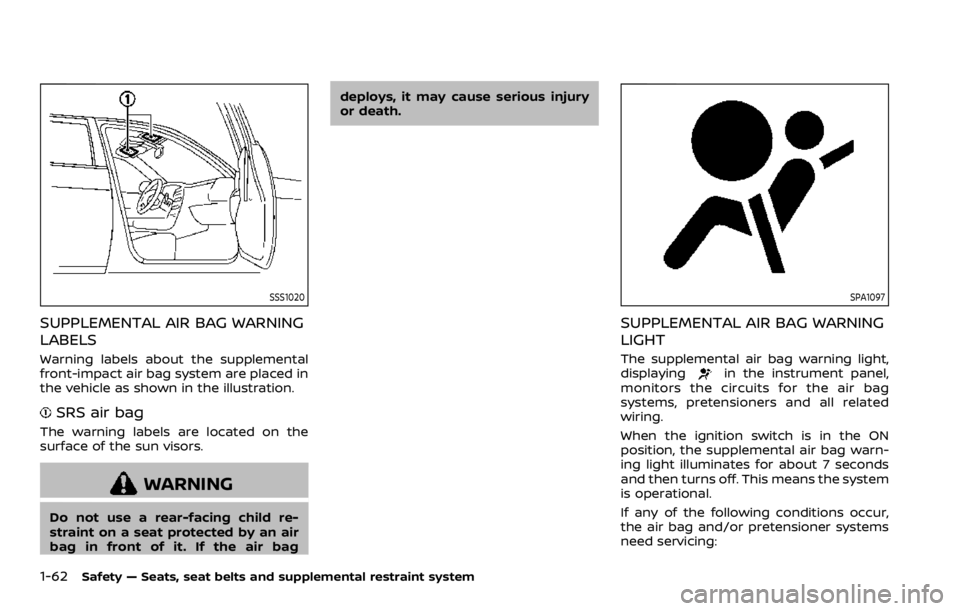
1-62Safety — Seats, seat belts and supplemental restraint system
SSS1020
SUPPLEMENTAL AIR BAG WARNING
LABELS
Warning labels about the supplemental
front-impact air bag system are placed in
the vehicle as shown in the illustration.
SRS air bag
The warning labels are located on the
surface of the sun visors.
WARNING
Do not use a rear-facing child re-
straint on a seat protected by an air
bag in front of it. If the air bagdeploys, it may cause serious injury
or death.
SPA1097
SUPPLEMENTAL AIR BAG WARNING
LIGHT
The supplemental air bag warning light,
displayingin the instrument panel,
monitors the circuits for the air bag
systems, pretensioners and all related
wiring.
When the ignition switch is in the ON
position, the supplemental air bag warn-
ing light illuminates for about 7 seconds
and then turns off. This means the system
is operational.
If any of the following conditions occur,
the air bag and/or pretensioner systems
need servicing:
Page 81 of 492
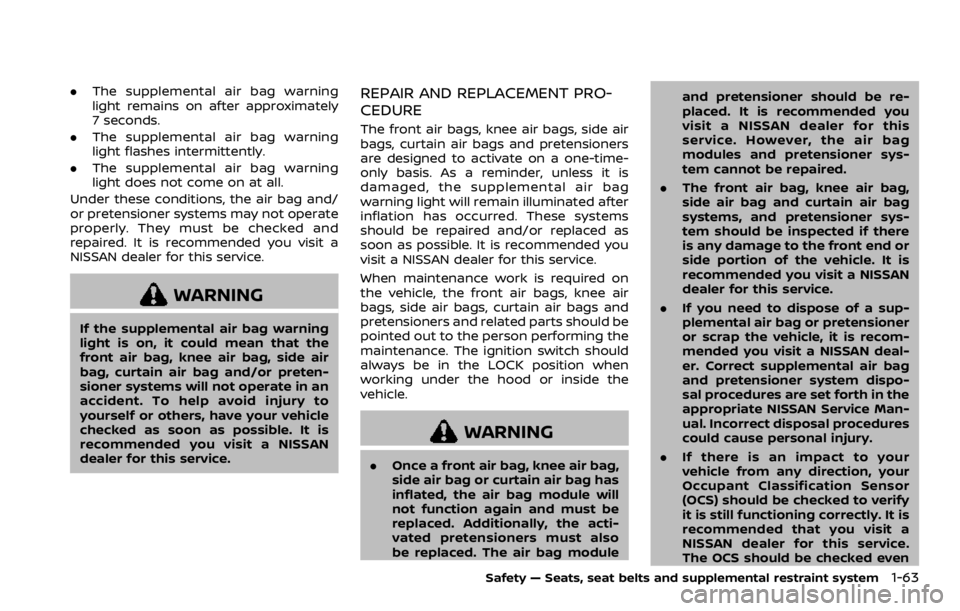
.The supplemental air bag warning
light remains on after approximately
7 seconds.
. The supplemental air bag warning
light flashes intermittently.
. The supplemental air bag warning
light does not come on at all.
Under these conditions, the air bag and/
or pretensioner systems may not operate
properly. They must be checked and
repaired. It is recommended you visit a
NISSAN dealer for this service.
WARNING
If the supplemental air bag warning
light is on, it could mean that the
front air bag, knee air bag, side air
bag, curtain air bag and/or preten-
sioner systems will not operate in an
accident. To help avoid injury to
yourself or others, have your vehicle
checked as soon as possible. It is
recommended you visit a NISSAN
dealer for this service.
REPAIR AND REPLACEMENT PRO-
CEDURE
The front air bags, knee air bags, side air
bags, curtain air bags and pretensioners
are designed to activate on a one-time-
only basis. As a reminder, unless it is
damaged, the supplemental air bag
warning light will remain illuminated after
inflation has occurred. These systems
should be repaired and/or replaced as
soon as possible. It is recommended you
visit a NISSAN dealer for this service.
When maintenance work is required on
the vehicle, the front air bags, knee air
bags, side air bags, curtain air bags and
pretensioners and related parts should be
pointed out to the person performing the
maintenance. The ignition switch should
always be in the LOCK position when
working under the hood or inside the
vehicle.
WARNING
. Once a front air bag, knee air bag,
side air bag or curtain air bag has
inflated, the air bag module will
not function again and must be
replaced. Additionally, the acti-
vated pretensioners must also
be replaced. The air bag module and pretensioner should be re-
placed. It is recommended you
visit a NISSAN dealer for this
service. However, the air bag
modules and pretensioner sys-
tem cannot be repaired.
. The front air bag, knee air bag,
side air bag and curtain air bag
systems, and pretensioner sys-
tem should be inspected if there
is any damage to the front end or
side portion of the vehicle. It is
recommended you visit a NISSAN
dealer for this service.
. If you need to dispose of a sup-
plemental air bag or pretensioner
or scrap the vehicle, it is recom-
mended you visit a NISSAN deal-
er. Correct supplemental air bag
and pretensioner system dispo-
sal procedures are set forth in the
appropriate NISSAN Service Man-
ual. Incorrect disposal procedures
could cause personal injury.
. If there is an impact to your
vehicle from any direction, your
Occupant Classification Sensor
(OCS) should be checked to verify
it is still functioning correctly. It is
recommended that you visit a
NISSAN dealer for this service.
The OCS should be checked even
Safety — Seats, seat belts and supplemental restraint system1-63